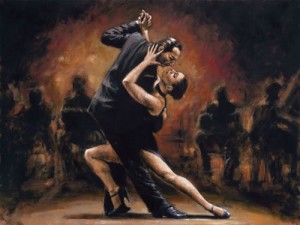Don’t forget! You’ve still got time to register to win a free copy of Fatal Tango by Wolfram Fleischhauer. Today, I wanted to share some cool information on the language of the tango and the codes that dancers use. This was provided by the author, although the illustration is from a painting by Fabian Perez (more info here).
The Art of Tango:
In real life, tango can also be in code. Fleischhauer interviewed professional dancers in Buenos Aires and asked them to reveal their personal tango notation systems. Most couples have some kind of system to memorize their complex choreographies.
How Tango Can Reveal Secrets:
In the example below, Fleischhauer shows from a dancer’s perspective how tango code might reveal the truth about a romance—will it be a thriller, or just more filler?
The music starts…
Step: Tijera — Scissor: A movement, usually danced by the man, in which an extended leg is withdrawn and crossed in front of the supporting leg without weight so that it remains free for the next step or movement.
Possible Interpretation: “Interesting, he really likes to dance these tijeras. Not the kind of sequence you would expect the first time you are dancing with a stranger, but let’s wait and see where this is all going.”
Step: Enganche — Hooking; coupling; the little hook: Occurs when a partner wraps a leg around the other’s leg, or uses a foot to catch and hold the other’s foot or ankle.
Possible Interpretation: “That enganche is really a little early for my taste. Strange, he does not really strike me as the pushy type at all. I´ve been watching him with other women, obviously, and I know he has been watching me. Is he doing all of this to show off to someone else?”
Step: Adorno — Adornment; embellishment; decoration: Complicated or syncopated movements which the dancer uses to demonstrate their skill and to interpret the music.
Possible Interpretation: “Yes. I better stay on my guard with this guy. All these adornos probably aren´t event meant for me. Is he dancing with me at all? He’s so self-absorbed he probably would not even notice if I did one myself. Let’s see. OK, I was wrong. He did notice. And I can just sense he is going to pick up on it …”
Step: Desplazamiento — Displacement: Displacing the partner’s leg or foot using one’s own leg or foot.
Possible Interpretation: “I was right. But what is he really trying to say now with this desplazamiento. My guess still is he is just very much in love with himself.”
Step: Ocho Cortado — Cut eight: change of direction. Typical in club-style tango where many such brakes are used to avoid collisions. Describes a movement done on either foot, pivoting forward or backward, and going either left or right.
Possible Interpretation: “Well, maybe not, after all. The way he just looked at me while he was doing these subtle ocho cortados. I must say, that was really exquisite. I wouldn’t mind to dance a whole tanda with him.”
Step: Rabona: — A walking step with a syncopated cross. Done forward or backward the dancer steps on a beat, quickly closes the other foot in cruzada, and steps again on the next beat. Adapted from soccer.
Possible Interpretation: “Hmmm, I just love it when the ochos get even more syncopated into rabonas. And he’s only looking at me now. Who is he, anyway? He´s cautious, but confident, and likes to surprise with suggestive little details.”
The music stops. We stand in a tight embrace, maybe a little too tight now, leaning on each other as the cortina jingle sets in.
“Otra vez?” he asks as the cortina fades and tango music sets in again. “Once more?” And then the penny drops: tijeras, enganche, adorno, desplazamiento, ocho cortado, rabono… otra vez? T.e. a.d.o.r.o… I adore you! What a charmer.


